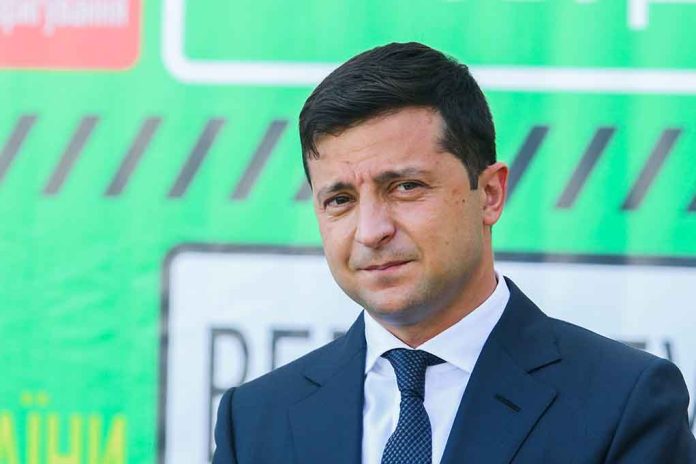
Ukrainian President Volodymyr Zelenskyy announces a significant military advance into Russia’s Kursk region, aiming to establish a buffer zone.
At a Glance
- Ukraine’s military incursion aims to create a buffer zone to prevent further Russian attacks.
- The operation began on August 6 to protect communities in the bordering Sumy region.
- Key bridges in the Kursk region have been destroyed, disrupting supply lines for Russian forces.
- The incursion has bolstered Ukrainian morale following previous setbacks in the conflict.
Zelenskyy Outlines Strategic Goals
President Volodymyr Zelenskyy has declared that the primary objective of the military advance into Russia’s Kursk region is to create a buffer zone. This zone aims to prevent further aggression from Moscow and enhance Ukraine’s defensive posture. In an effort that began on August 6, Ukrainian forces have moved to protect communities in the bordering Sumy region from relentless shelling.
Zelenskyy stated, “It is now our primary task in defensive operations overall: to destroy as much Russian war potential as possible and conduct maximum counteroffensive actions. This includes creating a buffer zone on the aggressor’s territory -– our operation in the Kursk region.”
The Ukrainian military has targeted critical infrastructure to impede Russian supply lines. On August 7, Ukrainian air force chief Lt. Gen. Mykola Oleshchuk released a video showing an airstrike that cut a bridge in the Kursk region in two. Ukrainian forces also hit a second bridge, with Russian Telegram channels claiming it was over the Seim River in the village of Zvannoe.
Ukrainian President Volodymyr Zelenskyy said the daring military incursion into Russia’s Kursk region aims to create a buffer zone to prevent further attacks by Moscow across the border. https://t.co/ZbHK8BrZ1c
— WSVN 7 News (@wsvn) August 18, 2024
Impact on Russian Tactical Capabilities
Ukrainian troops have struck key bridges in the Kursk region, disrupting supply lines for Russian forces. Pro-Kremlin military bloggers acknowledged that the destruction of these bridges would significantly impede Russian supply delivery. Ukraine’s aggressive push into Kursk resulted in the destruction of two bridges, leaving only one intact bridge in the area, further complicating Moscow’s efforts to replenish its forces and evacuate civilians.
Vladimir Putin previously acknowledged that creating buffer zones was a necessary strategy, saying, “I have said publicly that if it continues, we will be forced to create a security zone, a sanitary zone. That’s what we are doing.”
Ukrainian President Volodymyr Zelenskyy said the daring military incursion into Russia’s Kursk region aims to create a buffer zone to prevent further attacks by Moscow across the border. https://t.co/ZbHK8BrZ1c
— WSVN 7 News (@wsvn) August 18, 2024
Motivations and Morale
While Kyiv has been reticent about its ultimate goals, the operation has had a noticeable impact on morale back home. The advance into Kursk has rejuvenated spirits, particularly after Ukraine faced setbacks in a failed counteroffensive and Russian gains in the eastern Donbas region. Ukraine’s objectives within Kursk include not just immediate tactical gains but also broader strategic advantages, including putting pressure on Moscow to reconsider its aggressive actions.
President Zelenskyy emphasized the necessity for Western allies to lift restrictions on using their weapons for deeper strikes into Russian territory. “It is crucial that our partners remove barriers that hinder us from weakening Russian positions in the way this war demands. … The bravery of our soldiers and the resilience of our combat brigades compensate for the lack of essential decisions from our partners,” said Zelenskyy.
Ukrainian President Volodymyr Zelenskyy said the daring military incursion into Russia’s Kursk region aims to create a buffer zone to prevent further attacks by Moscow across the border. https://t.co/ZbHK8BrZ1c
— WSVN 7 News (@wsvn) August 18, 2024
Future Ramifications
As Ukrainian forces advance deeply into Kursk, they face the challenge of maintaining supply lines while being in enemy territory. Analysts warn that the success of this operation hinges on the ability to secure logistical routes, and its long-term sustainability remains in question. However, the immediate gains have visibly disrupted Russian tactical logistics and operations.
Ukrainian officials have captured more than 150 Russian prisoners of war on some days, many of whom were young conscripts. The Institute for the Study of War reported rapid Ukrainian advances through 800 sq km in the first six days, targeting unprepared Russian positions.





